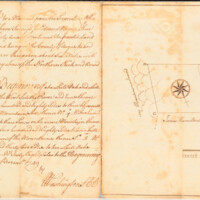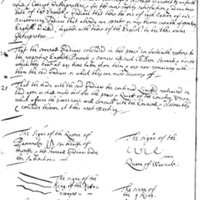Colonization and Settlement
1607-1763

Government structure and political life had distinct characteristics in New England, the Mid-Atlantic, and the South as they groped their way toward mature political institutions. Economics were affected by geographic location and the local natural resources, adding to regional differences, and sometimes, divisions. Religion and politics were often influenced by the European nation who colonized the area – French, Spanish, Dutch, or English. Religion was a defining characteristic of some colonies, as opposed to the economic reasons for which others were established. Ideas of religious freedom, denominationalism, and the Great Awakening all impacted daily life.
Learn more in the National U.S. History Content Standards.
Recently added items
Treaty of Middle Plantation, Signature page, 1677
English expansion into Indigenous territories led to several violent eruptions of conflict in the first decades of settlement in Virginia. A series of wars called the Anglo-Powhatan Wars ended in 1646 with the death of Opechancanough, brother of…
Cockacoeske, Frontlet from King Charles II, 1677
Cockacoeske was a significant figure in the history of the Pamunkey tribe in Virginia. She was a descendant of Opechancanough, the brother of Powhatan, who had been the paramount chief of the Powhatan Confederacy. Cockacoeske became weroansqua, or…
Letter from Lt. Gov. Alexander Spotswood About Educating Indians, 1711
The Brafferton School was one of several colonial “Indian Schools” intended to Christianize and educate Indigenous men and boys in a western scholastic tradition. It was part of a larger effort by Europeans to westernize and Christianize the…
Pamunkey Employment, Petition, 1711
Relations between Virgina's Indigenous peoples and the colonists who wanted to settle on their land were often contentious and violent. Virginia's colonial government passed multiple laws in the 17th century to regulate the actions of settlers and…




